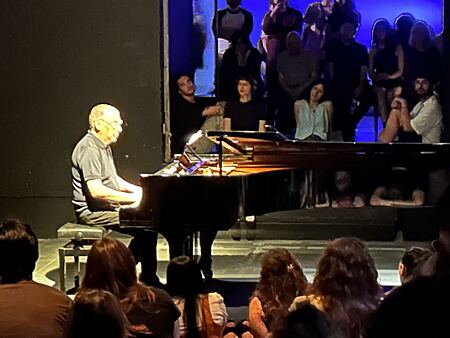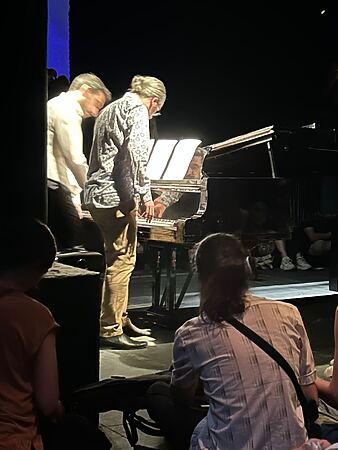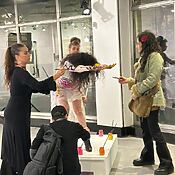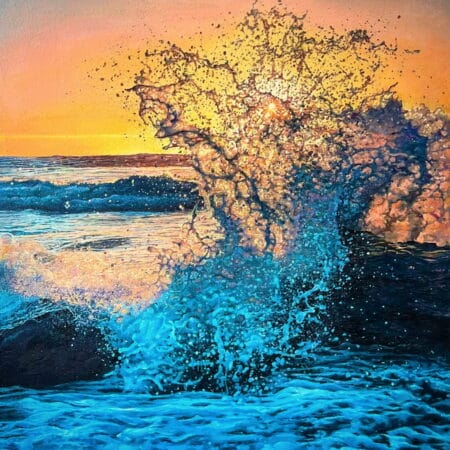The Colón Theater in Buenos Aires needs no introduction. Its acoustics are legendary, and it has been praised by great singers such as Johnas Kaufmann, Montserrat Caballé , and Plácido Domingo . Every year, it is visited by orchestras and tourists from all over the world. Its spacious auditorium and seven floors have been photographed countless times and are considered a symbol of the city.
What few people know is that deep inside, in the theater's basement, lies another stage: that of the Centro de Experimentación del Teatro Colón (Theatre Experimental Laboratory), often simply CETC . Founded in 1989, this space presents and creates innovative performances across various genres.
This year, his proposal, " Erik Satie: 100 Years – Vexations," generated considerable interest. It involves a marathon performance in which the piece "Vexations" is to be played at least 840 times, as indicated in the title of Satie . This work is one of the earliest examples of a repetitive arrangement. The short atonal melody is underpinned by two different harmonies and, once played, lasts only between one and two minutes.
Satie's instructions are clear:
To play this motif 840 times without a break, it is recommended to prepare beforehand in great silence and serious immobility.”
And that's precisely what many pianists are doing now. The young Erik Satie was the resident pianist at the famous Salon de la Rose-Croix , a significant venue in the Parisian art scene of the late 19th century. The eccentric art critic Józephin Peladán advocated the fusion of the arts, and music played a key role in his annual exhibitions.
There, Satie the visual artist Suzanne Valadón , with whom he embarked on a passionate love affair that, although lasting only six months, would profoundly affect the composer for the rest of his life. As a farewell, he composed Vexations , a piece reflecting his pain after the separation. The music is slow and atmospheric and shares some formal similarities with the Gregorian chant with which Satie was studying during those years.
It was John Cage , the influential American composer, who years later discovered the manuscript in a private collection and decided to present it to the public for the first time. The performance took place on September 9, 1963, at the Pocket Theatre in New York City, Foundation for Contemporary Art
To meet this challenge, Cage a large number of pianists, including Cristian Wolf, John Cale , and David Tudor . The pianists alternated in 20-minute intervals.
According to eyewitnesses, the 18-hour and 40-minute performance transformed into a kind of group meditation. In this type of group meditation, the personal style and techniques of the individual performers dissolved after the first few repetitions and surrendered to the music itself.

Admission is free and possible throughout the entire duration of the concert, which takes place from Friday, November 15th, at 8:30 pm until Saturday, November 16th, at the same time. The small, enigmatic, and melancholic melody constantly transforms, always the same yet always different, in a darkened space, accompanied only by an abstract video in neutral colors, whose rhythm contrasts with the melody.
A long queue already surrounded the theater last night, clearly demonstrating the audience's enthusiasm for this kind of novel experience. The hall seats two hundred people, who sit in armchairs or on comfortable cushions. The distance to the performer is minimal. With each repetition, the music becomes pure time, an invitation to lose oneself and to find oneself again with oneself and with others who share this experience.
I'm not a Satie ; my favorite piece is actually his Gnossiennes 1 , perhaps the most tonal and joyful of all his works, so not Satie in the truest sense of the word. But if you're in Buenos Aires, you shouldn't miss this opportunity. It's a unique experience!

Laura Ragucci is a multifaceted artist who works as an art critic, teacher, artist, and photographer. Her passion for art and culture is enriched by her extensive travel experiences, which have allowed her to integrate diverse cultural influences into her work.
After years of studying languages and working with computer science, she turned to creative expression through photography and writing. Since 2020, she has devoted herself primarily to art criticism, drawing on her studies at the National University of Art (UNA).
She writes her art reviews purely for the joy of artistic discourse. Laura embodies the spirit of a tireless explorer whose curiosity has led her down diverse paths.
















